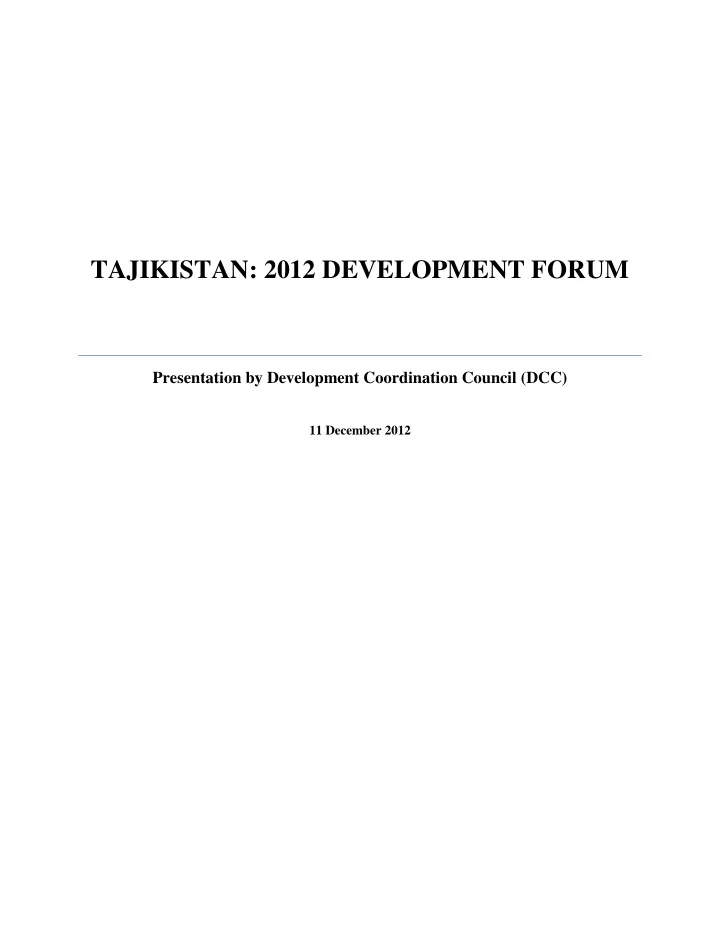

TAJIKISTAN: 2012 DEVELOPMENT FORUM Presentation by Development Coordination Council (DCC) 11 December 2012
CONTENTS I. INTRODUCTION ................................................................................................................................ 2 PRS-3 OUTCOMES — RETROSPECTIVE.......................................................................................... 2 II. A. Macroeconomic Trends — Steady progress ....................................................................................... 2 Millennium Development Goals (MDGs) — Uneven progress.......................................................... 3 B. Private Sector — Important laws adopted, but implementation now critical ..................................... 4 C. D. Public Administration and Governance — Slow but steady progress ................................................ 5 Energy Security, Food Security, and Connectivity — Presidential Priorities .................................... 6 E. GOING FORWARD — THEMES AND POLICY MESSAGES FOR 2013-15 III. ............................... 7 A. Putting People as Priority .................................................................................................................. 7 B. Planning for and Managing Risks .................................................................................................... 8 C. Using Public Resources Wisely ........................................................................................................ 9 D. Increasing the Role of the Private Sector .......................................................................................... 9 IV. DCC DEVELOPMENT PARTNER INITIATIVES ...................................................................... 10 Annex 1: DCC Development Partners’ Commitments 2010 -12 13 .......................................................................... 15 Annex 2: Summary of World Bank 2012 Survey: Access to and Quality of Public Services.............................. 23 Annex 3: Shared Principles for Cooperation (2013-2015) ................................................................................. 25 Annex 4: List of DCC Members and Representatives ......................................................................................... 1
TAJIKISTAN: DEVELOPMENT FORUM Dushanbe, December 11, 2012 Presentation by Development Coordination Council (DCC) I. INTRODUCTION The overall objective of the Development Coordination Council (DCC) 1 is to improve the 1. efficiency and effectiveness of its members’ development activities in Tajikistan — a goal that is anchored in the 2005 Paris Declaration on Aid Effectiveness and the subsequent 2008 Accra Agenda and 2011 Busan Partnership. To this end, it facilitates the exchange of information and promotes cooperation between members and, in addition, undertakes dialogue with th e government on the country’s development priorities. DCC support for Tajikistan’s 3 rd Poverty Reduction Strategy (PRS-3), whose commitments totaled just over $1.3 billion during 2010-12 ( cf. Annex 1), was guided by nine country- specific shared principles of aid effectiveness linked to the targets for 2010 set out in the Paris Declaration. Likewise, DCC support for the country’s new medium-term Living Standards Improvement Strategy (LSIS) will be based on the updated list of ten Shared Principles for Cooperation attached to this report. These reflect not only the intent of the original Paris Declaration but also the four priorities agreed at the 4 th High Level Forum in Busan last year, namely: country ownership of development; focus on results; inclusive development partnerships; and, transparency and mutual accountability. 2 This paper assesses what, in DCC development partners’ view , were the principal outcomes 2. of the PRS-3 (2010-12) and suggests key development challenges and policy priorities for the LSIS period (2013-15). Its final section besides re-affirming continued DCC support for Taj ikistan’s development, proposes several cross-sectoral, multi-partner initiatives designed to achieve measurable results by 2015 in the LSIS’ six priority areas, namely: public administration and governance; private sector-led growth; development of human potential; energy independence; food security; and, transport connectivity PRS-3 OUTCOMES — RETROSPECTIVE II. A. Macroeconomic Trends — Steady progress 3. Tajikistan withstood the 2008-09 global downturn better than expected, thanks partly to prudent economic management and partly to timely support from development partners . The main effects of the crisis were twofold: a 30% decline in remittances from Tajik migrants in Russia (from $2.3 billion in 2008 to $1.6 billion in 2009); and lower international prices as well as reduced exports of aluminum and cotton. Consequently, GDP growth fell from 7.9% in 2008 to 3.9% in 2009. The authorities’ two-pronged anti-crisis strategy comprised increased public spending, including on social programs designed to create jobs, and greater exchange rate flexibility to facilitate current account adjustment. At the same time, budget support totaling about $288 million and technical assistance from several DCC members helped maintain public expenditures on education, health, and social protection and helped government efforts to mitigate the crisis’ impact on poverty and vulnerability. 4. The economy recovered quickly following the 2009 slowdown and the medium-term outlook is favorable. Real GDP expanded by 6.5% and 7.4% in 2010 and 2011 respectively and by 7.5% during 1 The DCC currently comprises representatives of 26 bilateral, multilateral and United Nations agencies (www.untj.org/dcc) 2 Busan Partnership for Effective Development Cooperation (paragraph 11), December 1, 2011 2
Recommend
More recommend